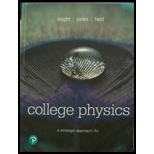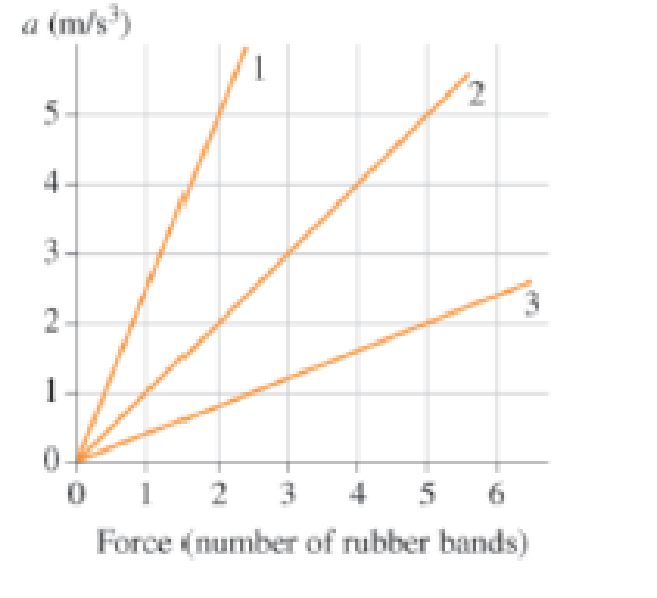
Pearson eText for College Physics: A Strategic Approach -- Instant Access (Pearson+)
4th Edition
ISBN: 9780137561520
Author: Randall Knight, Brian Jones
Publisher: PEARSON+
expand_more
expand_more
format_list_bulleted
Concept explainers
Textbook Question
Chapter 4, Problem 13P
Figure P4.13 shows an acceleration-versus-force graph for three objects pulled by rubber bands. The mass of object 2 is 0.20 kg. What are the masses of objects 1 and 3? Explain your reasoning.

Figure P4.13
Expert Solution & Answer
Learn your wayIncludes step-by-step video

schedule05:00
Students have asked these similar questions
How is it that part a is connected to part b? I can't seem to solve either part and don't see the connection between the two.
Hello, please help with inputing trial one into the equation, I just need a model for the first one so I can answer the rest. Also, does my data have the correct sigfig?
Thanks!
Find the current in the R₁ resistor in the drawing
(V₁=16.0V, V2=23.0 V, V₂ = 16.0V, R₁ = 2005, R₂ =
and R₂ = 2.705)
2.3052
VIT
A
www
R
www
R₂
R₂
Va
Chapter 4 Solutions
Pearson eText for College Physics: A Strategic Approach -- Instant Access (Pearson+)
Ch. 4 - If an object is not moving, does that mean that...Ch. 4 - An object moves in a straight line at a constant...Ch. 4 - If you know all of the forces acting on a moving...Ch. 4 - Three arrows are shot horizontally. They have left...Ch. 4 - Prob. 5CQCh. 4 - Internal injuries in vehicular acci-dents may be...Ch. 4 - Heres a great everyday use of the physics...Ch. 4 - Prob. 8CQCh. 4 - Suppose you are an astronaut in deep space, far...Ch. 4 - Jonathan accelerates away from a stop sign. His...
Ch. 4 - Prob. 11CQCh. 4 - Prob. 12CQCh. 4 - Josh and Taylor, standing face-to-face on...Ch. 4 - A person sits on a sloped hillside. Is it ever...Ch. 4 - Walking without slipping requires a static...Ch. 4 - Figure 4.30 b showed a situation in which the...Ch. 4 - Prob. 17CQCh. 4 - Prob. 18CQCh. 4 - The tire on this drag racer is severely twisted:...Ch. 4 - Suppose that, while in a squatting position, you...Ch. 4 - A block has acceleration a when pulled by a...Ch. 4 - A 5.0 kg block has an acceleration of 0.20 m/s2...Ch. 4 - Tennis balls experience a large drag force. A...Ch. 4 - A group of students is making model cars that will...Ch. 4 - A person gives a box a shove so that it slides up...Ch. 4 - Prob. 26MCQCh. 4 - As shown in the chapter, scallops use jet...Ch. 4 - Prob. 28MCQCh. 4 - Prob. 29MCQCh. 4 - Dave pushes his four-year-old son Thomas across...Ch. 4 - Figure Q4.29 shows block A sitting on top of block...Ch. 4 - Whiplash injuries during an automobile accident...Ch. 4 - An automobile has a head-on collision. A passenger...Ch. 4 - In a head-on collision, an infant is much safer in...Ch. 4 - Problems 4 through 6 show two forces acting on an...Ch. 4 - Problems 4 through 6 show two forces acting on an...Ch. 4 - Problems 4 through 6 show two forces acting on an...Ch. 4 - Prob. 7PCh. 4 - Prob. 8PCh. 4 - A baseball player is sliding into second base....Ch. 4 - A jet plane is speeding down the runway during...Ch. 4 - A skier is sliding down a 15 slope. Friction is...Ch. 4 - A falcon is hovering above the ground, then...Ch. 4 - Figure P4.13 shows an acceleration-versus-force...Ch. 4 - A constant force applied to object A causes it to...Ch. 4 - A compact car has a maximum acceleration of 4.0...Ch. 4 - Prob. 16PCh. 4 - A constant force is applied to an object, causing...Ch. 4 - A man pulling an empty wagon causes it to...Ch. 4 - Prob. 19PCh. 4 - Scallops eject water from their shells to provide...Ch. 4 - Figure P4.21 shows an objects...Ch. 4 - Prob. 22PCh. 4 - Two children fight over a 200 g stuffed bear. The...Ch. 4 - Prob. 24PCh. 4 - Prob. 25PCh. 4 - Prob. 26PCh. 4 - Prob. 27PCh. 4 - Prob. 28PCh. 4 - Problems 27 through 29 show a free-body diagram....Ch. 4 - Problems 27 through 29 show a free-body diagram....Ch. 4 - Problems 27 through 29 show a free-body diagram....Ch. 4 - Prob. 32PCh. 4 - Problems 30 through 38 describe a situation. For...Ch. 4 - Problems 30 through 38 describe a situation. For...Ch. 4 - Problems 30 through 38 describe a situation. For...Ch. 4 - Problems 30 through 38 describe a situation. For...Ch. 4 - Problems 30 through 38 describe a situation. For...Ch. 4 - Prob. 38PCh. 4 - Problems 30 through 38 describe a situation. For...Ch. 4 - Problems 30 through 38 describe a situation. For...Ch. 4 - Prob. 41PCh. 4 - Prob. 42PCh. 4 - Three ice skaters, numbered 1, 2, and 3, stand in...Ch. 4 - A girl stands on a sofa. Identify all the...Ch. 4 - A car is skidding to a stop on a level stretch of...Ch. 4 - Squid use jet propulsion for rapid escapes. A...Ch. 4 - Prob. 47GPCh. 4 - Prob. 48GPCh. 4 - Prob. 49GPCh. 4 - Prob. 50GPCh. 4 - Prob. 51GPCh. 4 - Prob. 52GPCh. 4 - Problems 49 through 61 describe a situation. For...Ch. 4 - Problems 49 through 61 describe a situation. For...Ch. 4 - Problems 49 through 61 describe a situation. For...Ch. 4 - Prob. 56GPCh. 4 - Prob. 57GPCh. 4 - Problems 49 through 61 describe a situation. For...Ch. 4 - Problems 49 through 61 describe a situation. For...Ch. 4 - Prob. 60GPCh. 4 - Problems 49 through 61 describe a situation. For...Ch. 4 - Problems 49 through 61 describe a situation. For...Ch. 4 - Problems 49 through 61 describe a situation. For...Ch. 4 - Problems 49 through 61 describe a situation. For...Ch. 4 - A bag of groceries is on the back seat of your car...Ch. 4 - A car has a mass of 1500 kg. If the driver applies...Ch. 4 - Prob. 67GPCh. 4 - Prob. 69GPCh. 4 - Prob. 70GPCh. 4 - Prob. 71GPCh. 4 - The froghopper, champion leaper of the insect...Ch. 4 - A beach ball is thrown straight up, and some time...Ch. 4 - If your car is stuck in the mud and you dont have...Ch. 4 - Prob. 75MSPPCh. 4 - Prob. 76MSPPCh. 4 - If your car is stuck in the mud and you don't have...
Additional Science Textbook Solutions
Find more solutions based on key concepts
18. SCIENTIFIC THINKING By measuring the fossil remains of Homo floresiensis, scientists have estimated its wei...
Campbell Biology: Concepts & Connections (9th Edition)
How many oxygen atoms are on the reactant side of this chemical equation? K2CO3(aq)+Pb(NO3)2(aq)2KNO3(aq)+PbCO3...
Introductory Chemistry (6th Edition)
Explain the role of gene flow in the biological species concept.
Campbell Biology (11th Edition)
Choose the best answer to each of the following. Explain your reasoning. When we see Saturn going through a per...
Cosmic Perspective Fundamentals
1.1 Write a one-sentence definition for each of the following:
a. chemistry
b. chemical
Chemistry: An Introduction to General, Organic, and Biological Chemistry (13th Edition)
22. A rock is tossed straight up from ground level with a speed of 20 m/s. When it returns, it falls into a hol...
Physics for Scientists and Engineers: A Strategic Approach, Vol. 1 (Chs 1-21) (4th Edition)
Knowledge Booster
Learn more about
Need a deep-dive on the concept behind this application? Look no further. Learn more about this topic, physics and related others by exploring similar questions and additional content below.Similar questions
- Which of the following laws is true regarding tensile strength? • tensile strength T ①Fbreak = Wtfest Piece thickness rate (mm) ②T = test piece width rabe (mm) Fbreak break watarrow_forwardThe position of a squirrel running in a park is given by = [(0.280 m/s)t + (0.0360 m/s²)t²] + (0.0190 m/s³)ť³ĵj. What is v₂(t), the x-component of the velocity of the squirrel, as a function of time?arrow_forwardNo chatgpt pls will upvotearrow_forward
- You hold a spherical salad bowl 85 cm in front of your face with the bottom of the bowl facing you. The salad bowl is made of polished metal with a 40 cm radius of curvature. Where is the image of your 2.0 cm tall nose located? What is image's size, orientation, and nature. I keep getting the answer -26.2, but it keeps saying it is wrong. I just want to know what i'm doing wrong.arrow_forwardA converging lens with a focal length of 6.70 cm forms an image of a 4.60 mm tall real object that is to the left of the lens. The image is 1.50 cm tall and erect. Where are the object and image located? Is the image real or virtual? Please show all stepsarrow_forwardNo chatgpt pls will upvotearrow_forward
- need help part earrow_forwardCritical damping is the case where the mass never actually crosses over equilibrium position, but reaches equilibrium as fast as possible. Experiment with changing c to find the critical damping constant. Use the same initial conditions as in the last problem. Zoom in a bit to make sure you don't allow any oscillations to take place - even small ones.arrow_forwardNASA's KC-135 Reduced Gravity Research aircraft, affectionately known as the "Vomit Comet," is used in training astronauts and testing equipment for microgravity environments. During a typical mission, the aircraft makes approximately 30 to 40 parabolic arcs. During each arc, the aircraft and objects inside it are in free-fall, and passengers float freely in apparent "weightlessness." The figure below shows the altitude of the aircraft during a typical mission. It climbs from 24,000 ft to 30,850 ft, where it begins a parabolic arc with a velocity of 155 m/s at 45.0° nose-high and exits with velocity 155 m/s at 45.0° nose-low. 31 000 45° nose high 45° nose low 24 000 Zero g 65 Maneuver time (s) (a) What is the aircraft's speed (in m/s) at the top of the parabolic arc? 110.0 m/s (b) What is the aircraft's altitude (in ft) at the top of the parabolic arc? 2.04e+04 What is the initial height at the start of the parabolic arc? What is the initial velocity at this point? What is the final…arrow_forward
arrow_back_ios
SEE MORE QUESTIONS
arrow_forward_ios
Recommended textbooks for you
 Glencoe Physics: Principles and Problems, Student...PhysicsISBN:9780078807213Author:Paul W. ZitzewitzPublisher:Glencoe/McGraw-Hill
Glencoe Physics: Principles and Problems, Student...PhysicsISBN:9780078807213Author:Paul W. ZitzewitzPublisher:Glencoe/McGraw-Hill Physics for Scientists and Engineers, Technology ...PhysicsISBN:9781305116399Author:Raymond A. Serway, John W. JewettPublisher:Cengage Learning
Physics for Scientists and Engineers, Technology ...PhysicsISBN:9781305116399Author:Raymond A. Serway, John W. JewettPublisher:Cengage Learning Principles of Physics: A Calculus-Based TextPhysicsISBN:9781133104261Author:Raymond A. Serway, John W. JewettPublisher:Cengage Learning
Principles of Physics: A Calculus-Based TextPhysicsISBN:9781133104261Author:Raymond A. Serway, John W. JewettPublisher:Cengage Learning University Physics Volume 1PhysicsISBN:9781938168277Author:William Moebs, Samuel J. Ling, Jeff SannyPublisher:OpenStax - Rice University
University Physics Volume 1PhysicsISBN:9781938168277Author:William Moebs, Samuel J. Ling, Jeff SannyPublisher:OpenStax - Rice University Physics for Scientists and Engineers: Foundations...PhysicsISBN:9781133939146Author:Katz, Debora M.Publisher:Cengage Learning
Physics for Scientists and Engineers: Foundations...PhysicsISBN:9781133939146Author:Katz, Debora M.Publisher:Cengage Learning College PhysicsPhysicsISBN:9781285737027Author:Raymond A. Serway, Chris VuillePublisher:Cengage Learning
College PhysicsPhysicsISBN:9781285737027Author:Raymond A. Serway, Chris VuillePublisher:Cengage Learning

Glencoe Physics: Principles and Problems, Student...
Physics
ISBN:9780078807213
Author:Paul W. Zitzewitz
Publisher:Glencoe/McGraw-Hill

Physics for Scientists and Engineers, Technology ...
Physics
ISBN:9781305116399
Author:Raymond A. Serway, John W. Jewett
Publisher:Cengage Learning

Principles of Physics: A Calculus-Based Text
Physics
ISBN:9781133104261
Author:Raymond A. Serway, John W. Jewett
Publisher:Cengage Learning

University Physics Volume 1
Physics
ISBN:9781938168277
Author:William Moebs, Samuel J. Ling, Jeff Sanny
Publisher:OpenStax - Rice University

Physics for Scientists and Engineers: Foundations...
Physics
ISBN:9781133939146
Author:Katz, Debora M.
Publisher:Cengage Learning

College Physics
Physics
ISBN:9781285737027
Author:Raymond A. Serway, Chris Vuille
Publisher:Cengage Learning
Newton's Third Law of Motion: Action and Reaction; Author: Professor Dave explains;https://www.youtube.com/watch?v=y61_VPKH2B4;License: Standard YouTube License, CC-BY